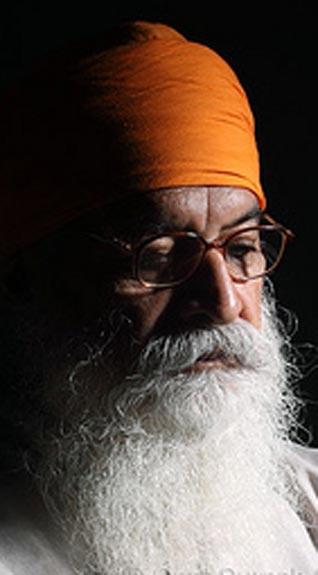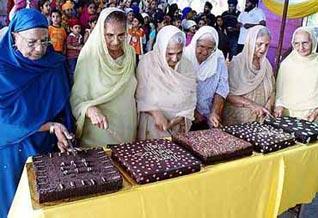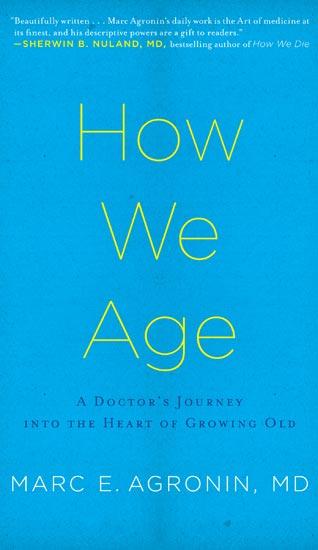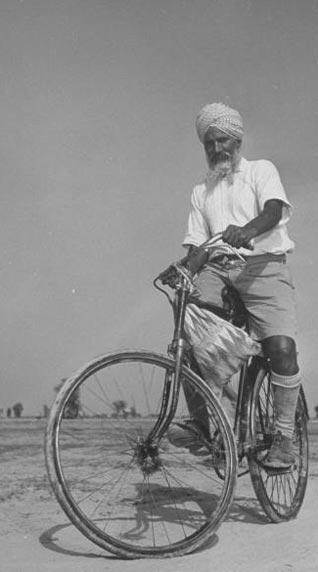Books
How We Age
A Book Review by DORIS PAVLICHEK
How We Age is sikhchic.com's Book of the Month selection for February, 2011
HOW WE AGE: A Doctor's Journey into the Heart of Growing Old, by Marc E. Agronin, M.D. De Capo Press, hardcover, pp 320, $25.00. ISBN-13: 9780306818530
Many books on the subject of aging have flooded the shelves and online queues of booksellers, taking advantage both of our fear of aging and our desire to find the fountain of youth.
Such is not the case in How We Age; as the author, Dr. Marc Agronin, himself points out in the introduction, his "intention is not to promise any cures for aging." Neither physical or mental gymnastics nor nutritional supplements are prescribed. Instead, Agronin is "interested solely in honestly exploring the experience of old age through the lives of [his nursing home] patients."
It would be a pity if
you were to pass up this important book simply because it does not
promise to extend your youth. How We Age is a remarkable treasure
that examines the process of human development into the latter stages
of life, explores the thoughts and experiences of those who are into
their eighties or beyond, and questions whether life's purpose does not
make itself best known to us as we enter the sunset years.
How We Age is organized in five parts, each of which explores a different facet of aging through the eyes of doctor and patient alike.
In the first two parts, Agronin, a geriatric psychiatrist, examines what
it means to grow "old"- what it looks like and how it is perceived by
those caring for or related to the patient. As he points out, no stage
of life has a more "feared and mysterious ending" than the elder years,
since they inevitably end in death.
Many of his patients have not only
one of "The Four Horsemen of Old Age" (depression, dementia, delirium,
and destitution) but also concomitant ailments such as post-traumatic
stress disorder (PTSD), generally as a result of the war or the
Jewish Holocaust. Some of the stories presented are haunting tales of the
resiliency of the human spirit.
One patient, Emma, decides she no longer wants to live. As a young
mother in 1942, she had watched as her husband and all four of their
children were taken away from their home and sent to Nazi death camps.
Only her youngest child, with whom she was later reunited, survived.
Agronin struggles to encourage and save Emma, but it is her reunion with
her recently widowed sister-in-law in the nursing home that gives her a
renewed sense of purpose. Emma then lives to nearly one hundred and
two.
In Part III, Agronin discusses that which we may fear most - the loss of
our memories. He observes that while memory may indeed fade in old age,
wisdom grows. It is this "hidden strength ... [which] guide[s] and
balance[s] a person's life" that is often overlooked when we choose to
see only the infirmities of the body and mind in the elderly.
It is through his observation of a patient communicating in his first language (though he can no longer communicate in English) that Agronin learns to see the "sparks of the person hidden under the burden of disease." By observing acts of kindness, such as when a neighbor makes a scrapbook for one of his patients to help her remember, he sees how we can "help rejuvenate the person behind the lost memories."
Such observations beg
the question of whether the sharpness of memory is as important as a
more holistic view of life's purpose and meaning viewed from its final
stage.
Agronin explores the positive effects of aging by further considering
wisdom in Part IV. A longitudinal study published last year showed that,
in some ways, life begins in middle age - or at least the happiest part
of it does. An upswing in mood begins just around the time in which many
are looking to a facelift, a tummy tuck, or Botox injections to revive
their lost youth.
Amazingly, the study showed that "self-reported well-being and happiness" for the study subjects began to improve after age fifty and nearly peaked "at age eighty-five." Perhaps because the burden of the "pursuit of physical pleasures ... [is] lifted in later life," older people are free to pursue the spirituality, creativity, and moment-by-moment happiness that nurture the wisdom we often attribute to our elders.
Wisdom, Agronin states, is "not sitting in judgment like
King Solomon" but is something that "shines forth in the daily tumult of
aging." It is that certain something that brings peace to a person who
may have lost so much - loved ones, bodily and mental function, and
traditional, physical beauty.
In the closing section of the book, Agronin challenges our ageism and
points out that we are often more demonstrative of our affection for
someone after they have died.
"If we regard every second of life as precious," he asserts, "then the incredible degree of respect that we naturally accord to the deceased must also be extended to the living."
One way we can learn to appreciate the elderly is to spend time among
them. Agronin himself admits that he often forgets the gap in age
between himself and his patients, because he strives to see "positive
elements in [their] lives," not focusing only on "the physical or mental
decline of aging."
One of the most readable, engaging books I have encountered in a long time, How We Age
is reminiscent of Oliver Sacks' method of finding the person inside the
illness (or age). Agronin is the doctor we should all wish for when we
find ourselves, in that late stage of life, confused, lost, or unable to
communicate the way we once did. He seems to truly understand that we
cannot judge a book, nor an elder, by its cover.
[Courtesy: Internet Review of Books]
February 1, 2011
Conversation about this article
1: Sangat Singh (Kuala Lumpur, Malaysia), February 01, 2011, 7:15 PM.
A colleague of mine about to retire phoned me urgently asking how I had prepared for retirement. I told him that I started preparation the day I started to work. And, added in my usual style: "I am so busy in my retirement and have often wondered how the heck I had time to work all these years." On the day of my retirement, my 100 year-old company had a tradition to invite the retiring executive to what they called a "Director's Farewell Lunch/ Dinner." The MD/ CEO's secretary phoned me to ask the kind of food I would prefer. I said I wasn't too fussy about food but just to be on the safe side, I said grilled fish would do. The next question she asked, what kind of fish would you prefer. Heck, I didn't know even the names of edible fishes, and told her" "Get me the expensive type.". In the usual farewell speech, the MD/ CEO Tan Sri Dr. Ani Arope, known for his wit, remarked: "Sangat, you can now devote full time to your numerous hobbies and, in particular, amateur radio and photography." In reply, I said, "Tan Sri, I will now let you in a secret that I have kept for 40 years. Amateur Radio and Photography were my profession, and Planting was my hobby. But, you know I was good at my hobby too." To summarize, the preparation: 1) Don't get left behind in the past. Treat each day as a gift, especially if you remain connected with Waheguru. 2) Don't execute your right to be a grouch. Spend time with grandchildren and teach them all the wonderful skills that you have accumulated in all those years. Tell them funny stories and make them laugh. They ask: "Why do the grandmothers love their grandchildren a lot?" The answer is: because they do not have children of their own. If any, they are out chasing their tails and have only time to say hi and bye.
2: Amarjit Singh Chandan (London, United Kingdom), February 02, 2011, 3:26 PM.
The bespectacled gursikh face in the picture on the home page (thumbnail) to this article is actually Baba Gurmukh Singh of Lalton (1888-1977), a Ghadar-Kirti and later communist leader of the Punjab. He was one of the passengers on the S.S. Komagata Maru who, on their return to India, actively joined the freedom movement and was exiled for life to the Andamans Islands. This and other pictures were taken by the American photographer Margaret Bourke-White for the LIFE Magazine in the village Chhina in Amritsar district in September 1946, when the local agitation was at its peak for more irrigation water, etc. LIFE, unfortunately, has not properly catalogued these photographs in its archive and refers to them just under the general category as 'Sikhs'. The Baba in another picture taken in Lahore by the same photographer is sitting with another comrade - both at leisure, with their heads bare and without turbans - and that person is the great revolutionary Teja Singh Sutantar.
3: J. Lusskin (Miami, Florida, U.S.A.), February 04, 2011, 5:55 PM.
Dr. Agronin shines a light on life and aging, illuminating it as something to savor and proudly cherish. This book is a gift demonstrating to us that our sunset years provide new opportunities, wisdom and a chance to review, evaluate and balance life's lessons as we age. Great read! I applaud this gifted physician and remarkable author!






